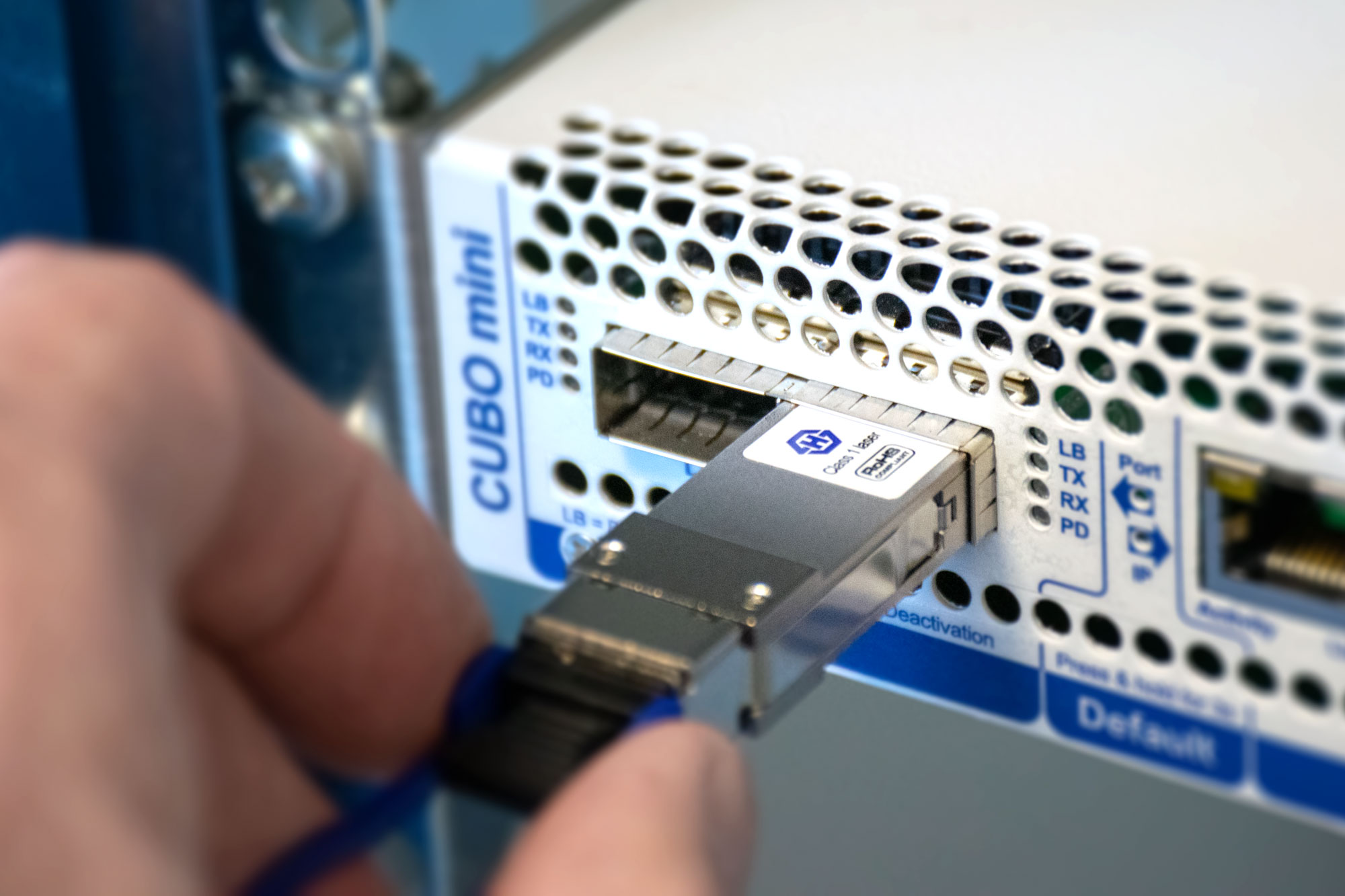How to choose a transceiver?

The key issue is, of course, to identify the service to be transported.
Is it :
- Ethernet ?
- Fibre?
- Or other services such as SDH (STM-n) or CPRI (for cellular network radio heads)?

We will then specify the d ata rate, from 1 to 400Gbit/s.
These two elements determine the mechanical format of the optical module :
- SFP for 1Gbit/s Ethernet or 1/2/4G Fibre Channel
- SFP+ for 10Gbit/s Ethernet or 16G/32G Fibre Channel
- QSFP+ for 40Gbit/s Ethernet
- QSFP28 (more rarely CFP, CFP2) for 100Gbit/s Ethernet
Of course, this mechanical format must match the «cage» offered by the service equipment. The brand and model of this latter must be known in order to ensure perfect compatibility. For instance, an optical module with a «Huawei» compatibility coding may not work when integrated into Cisco equipment.



Then, the transmission characteristics must be specified.
How far, using which type of optical fibre and according to which modality the optical signal will be transmitted?

For optical patch cords connecting two pieces of equipment of the same rack or room, the multimode «SR» short-range and very economical transceiver may be a fine solution, even though data centre operators are now favouring singlemode fibre. For a campus-wide pair of optical link of a few kilometres, the singlemode “LR” (Long range) will be appropriate.
For a “metropolitan” transmission, we can use the “ER” (Extended Range) optical modules covering distances of up to 40km or “ZR” for up to 80km.
There are also the so-called “bidirectional optical modules” (purchased by pair, the transmitters and receivers are being swapped) enabling the transmission on a single-strand fibre.
The distances mentioned here are indicative only, and it will be useful at a later stage to think in terms of the optical budget required, taking into consideration the expected attenuation of the used fibre.
The Telenco and HUBER+SUHNER Cube Optics® pre-sales experts are available to help with this calculation. Finally, as the long-distance fibre is often scarce and expensive, this one can be shared and more than one circuit can be transmitted over a single pair. That’s the advantage of the Wavelength Division Multiplexing (WDM).
Its dense variant, the DWDM, will enable up to 40 or even 128 channels to be carried over a single fibre pair, with the use of a passive multiplexer. In this case, the optical modules will be “coloured”, as they emit their signal at a very precise wavelength. Permissible wavelengths are standardised by ITU-T G.694.1 (DWDM) and G.694.2 (CWDM). In this case, the required wavelength (sometimes called “channel” in DWDM) must be clearly specified for each optical module.
The key issue is, of course, to identify the service to be transported.

Is it :
- Ethernet ?
- Fibre Channel ?
- Or other services such as SDH (STM-n) or CPRI (for cellular network radio heads) ?
We will then specify the data rate, from 1 to 400Gbit/s.

These two elements determine the mechanical format of the optical module :
- SFP for 1Gbit/s Ethernet or 1/2/4G Fibre Channel
- SFP+ for 10Gbit/s Ethernet or 16G/32G Fibre Channel
- QSFP+ for 40Gbit/s Ethernet
- QSFP28 (more rarely CFP, CFP2) for 100Gbit/s Ethernet
Of course, this mechanical format must match with the «cage» offered by the service equipment. The brand and model of this latter must be known in order to ensure perfect compatibility. For instance, an optical module with a «Huawei» compatibility coding may not work when integrated into a Cisco equipment.


Then, the transmission characteristics must be specified. How far, using which type of optical fibre and according to which modality the optical signal will be transmitted?
For optical patchcords connecting two pieces of equipment of the same rack or room, the multimode «SR» short range and very economical transceiver may be a fine solution, even though datacenter operators are now favouring singlemode fibre.
For a campus-wide pair of optical link of a few kilometers, the singlemode “LR” (Long range) will be appropriate.
For a “metropolitan” transmission, we can use the “ER” (Extended Range) optical modules covering distances of up to 40km or “ZR” for up to 80km.
There are also the so-called “bidirectional optical modules” (and purchased by pair, the transmitters and receivers are being swapped) enabling the transmission on a single-strand fibre.
The distances mentioned here are indicative only, and it will be useful at a later stage to think in terms of optical budget required, taking into consideration the expected attenuation of the used fibre.
The Telenco and Huber+Suhner Cube Optics® pre-sales experts are available to help with this calculation. Finally, as the long-distance fibre is often scarce and expensive, this one can be shared and more than one circuit can be transmitted over a single pair. That’s the advantage of the Wavelength Division Multiplexing (WDM).
Its dense variant, the DWDM, will enable up to 40 or even 128 channels to be carried over a single fibre pair, with the use of a passive multiplexer. In this case, the optical modules will be “coloured”, as they emit their signal at a very precise wavelength. Permissible wavelength are standardised by ITU-T G.694.1 (DWDM) and G.694.2 (CWDM). In this case, the required wavelength (sometimes called “channel” in DWDM) must be clearly specified for each optical module.









